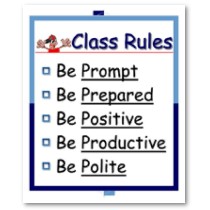Larry Cuban on School Reform and Classroom Practice: Meeting and Exceeding Student Expectations of Teachers: A Way to Achieve “Good” Teaching
Go into most public school classrooms and you will see a sign, usually in the front of the classroom, listing what the teacher expects of students in classroom behavior.
Experienced teachers advise new ones to make these rules explicit and enforce them from day one. Folk wisdom among veteran teachers is that expecting this behavior and equitably acting on the rules will lead to an orderly classroom. So most new and experienced teachers, believing this advice and wanting a well-managed classroom, list classroom rules. Some adventurous teachers have students construct the rules since they are well aware of acceptable classroom behavior from previous teachers).
In addition to behavior, what teachers expect of students academically influences achievement. Researchers have established that when teachers have high or low expectations of what their students can achieve–especially low-income and minority students–those expectations color what students do achieve (Journal of Teacher Education-1987-Good-32-47).
The point is that teacher expectations of student behavior and academic performance matter.
What is often missing from the advice given to teachers, however, is what goes on in students’ heads as they see a new teacher (novice or veteran) for the first time. Students also have an informal list of what behaviors, knowledge, and skills they expect of their teachers. And just like teacher expectations, student expectations matter.
Expectancy theory, as academics call it, involves motivation and choice–if I expect something I want to happen, I will choose that action that best achieves what I want. And that is true of student motivation and choosing what to do (or not do) in a classroom or lesson.
Beginning in kindergarten (or preschool), over the years students develop views of what a “good” teacher (and teaching) are. By the time, students are in high school, they have implicit models in their heads of who “good” teachers are and what they do in organizing and teaching a class.
By “good” teacher, most students mean one who mostly leads a teacher-centered, subject-driven academic class. The opposite of “good” is “bad.” For students meeting teachers for the first time, “bad” means the teacher tries to be friends with students, uses techniques (e.g., abandoning the textbook, peer grading of quizzes) that are seldom used by other “good” teachers. They tolerate student misbehavior and students ignoring what they say. In short, “bad” teachers cannot maintain minimum order in the classroom.
None of this is to mean that students’ pictures of “good” teachers are correct. Only that students already have images of what they believe is institutionally “good” for them.
So if a novice teacher (or veteran who transfer to a different school) believes that students have blank slates when they meet each other for the first time, they are whistling the wrong tune. Let me give examples of student expectations of teachers that I have encountered over the years.
*”Good” teachers know more facts and concepts than students do about the subject.
*”Good” teachers answer student questions clearly and correctly.
*”Good” teachers take time to explain complicated content.
*”Good” teachers do not publicly humiliate students.
*”Good” teachers assign homework from the text.
*”Good” teachers clamp down on late-comers to class
*”Good” teachers break up fights between students and protect weak students from being bullied.
*”Good” teachers do not permit students to copy from one another when expecting each student to do his or her work.
*”Good” teachers do not students to sleep in class.
For novices and veterans new to a school to ignore what students have learned about teachers and teaching for many years sitting in classrooms and is ultimately condescending since teachers are dismissing important student beliefs and knowledge. It also makes much harder the long-term task of developing strong relationships with the class as a whole and individual students–both essential for learning to occur.
There is a catch, however, when new and veteran teachers meet student expectations.
To do only what students expect is to be trapped by their traditional expectations of what a “good” teacher is. The tightrope act teachers have to negotiate is to initially meet what students expect–”good” teaching–then move beyond those beliefs to begin reshaping their expectations of “good” teaching to appreciate and learn from a far larger repertoire of classroom approaches and develop the personal relationships essential for learning to occur.
So, the essence of what I offer is for new and veteran teachers meeting their students for the first time is straight-forward: know what students expect of “good” teachers and teaching, meet those expectations, and then, once strong relationships have been formed with students, move beyond them so students can enlarge their picture of what “good” teachers and teaching are.
This blog post has been shared by permission from the author.
Readers wishing to comment on the content are encouraged to do so via the link to the original post.
Find the original post here:
The views expressed by the blogger are not necessarily those of NEPC.


